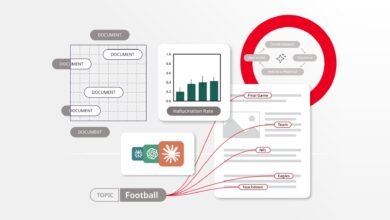The AI Revolution Is Built on a Flawed Foundation

▼ Summary
– Tech leaders claim superintelligent AI is imminent and will vastly accelerate scientific discovery, with some predicting arrival as early as 2026.
– Current AI systems like ChatGPT are large language models that primarily predict word correlations based on linguistic data, not true thinking or reasoning.
– Neuroscience research shows human thought is largely independent of language, as evidenced by brain imaging and individuals with language impairments retaining cognitive abilities.
– Scaling language models with more data and computing power is insufficient for achieving AGI because they emulate communication rather than genuine cognitive processes.
– Even advanced AI may only remix existing knowledge without making transformative leaps, as it lacks human capacity for paradigm-shifting creativity and dissatisfaction with current data.
The ambitious vision of an imminent artificial superintelligence, promising revolutionary scientific breakthroughs and even human immortality, rests upon a fundamentally questionable premise. Current large language models (LLMs) operate by analyzing statistical patterns in language data, not by replicating the multifaceted nature of human thought and reasoning. While tech leaders project boundless optimism, a closer look at the neuroscience of intelligence reveals a significant gap between their claims and scientific reality. These systems are sophisticated pattern-matching engines for text, not nascent minds on the verge of consciousness.
The core technology powering today’s high-profile AI chatbots, from ChatGPT to Claude and Gemini, is the large language model. Their operation is conceptually straightforward: they ingest colossal amounts of text, identify statistical relationships between words and sub-word units called tokens, and generate outputs by predicting the most probable sequence of words given a specific input. Despite the aura of complexity, they are, at their heart, sophisticated models of linguistic structure.
A critical problem emerges when we compare this architecture to what we know about human cognition. Modern neuroscience strongly indicates that human thinking operates largely independently of language. We use language to express the results of our reasoning, to form abstract concepts, and to generalize from experience, but language is the vehicle for communication, not the engine of thought itself. The ability to model language with increasing precision does not equate to creating a form of intelligence that matches or exceeds our own. This crucial distinction separates scientific evidence from the speculative narratives promoted by AI enthusiasts.
The prevailing hype suggests that simply amassing more data and increasing computational power will inevitably lead to artificial general intelligence (AGI). This “scaling is all you need” philosophy is scientifically tenuous. LLMs are tools that emulate the communicative output of language; they do not replicate the separate, internal cognitive processes of thinking, no matter how many data centers are constructed to support them.
A powerful commentary published last year in the journal Nature, titled “Language is primarily a tool for communication rather than thought,” synthesizes decades of research. Authored by scientists Evelina Fedorenko, Steven Piantadosi, and Edward Gibson, the article makes two central arguments. First, it dismantles the idea that language is the source of our capacity to think. Second, it builds the case that language evolved as a cultural tool for sharing thoughts between individuals.
Consider the first claim. Our introspection often leads us to believe we think in a language. However, if thought were dependent on language, then losing language would mean losing the ability to think. Empirical evidence shows this is not the case. Brain imaging studies using fMRI reveal that networks involved in cognitive tasks like math problem-solving or understanding others’ intentions are distinct from the brain regions dedicated to language processing.
Furthermore, studies of individuals with severe aphasia, a loss of language ability due to brain injury, demonstrate that their general cognitive faculties often remain intact. These individuals can still solve logical puzzles, understand non-verbal cues, and reason about cause and effect. Their capacity for thought persists even when their ability to articulate it through language is gone.
Observing an infant provides another clear demonstration. Babies actively explore their environment, conduct miniature experiments, and form theories about how the world works long before they can speak. They are clearly thinking and learning, relying on non-linguistic cognitive abilities.
This leads to the second major point: language is an exceptionally efficient tool for sharing thoughts. Human languages share universal features that make them easy to learn, produce, and understand. This “cognitive gadget,” as researcher Cecilia Heyes describes it, allows knowledge to be transmitted across individuals and generations with remarkable fidelity. Our cognition is undoubtedly enhanced by language, but it is not created by it. Remove language from a person, and a vast landscape of thought and experience remains. Remove language from an LLM, and nothing is left.
Some proponents argue that AI doesn’t need to mimic human cognition to achieve superintelligence, pointing to AI systems that mastered chess through unique methods. Perhaps a different path to intelligence exists. Yet, there is no compelling reason to believe that training exclusively on text data can lead to the broad, general intelligence humans possess. Much of human knowledge, like knowing how to ride a bicycle, is not easily translated into linguistic form.
A growing chorus within the AI community acknowledges the limitations of LLMs. Pioneers like Yann LeCun are now developing “world models” that aim to understand the physical world, possess memory, and demonstrate reasoning and planning abilities. A group of prominent AI scientists, including Yoshua Bengio and Gary Marcus, has proposed a definition of AGI that emphasizes “cognitive versatility,” viewing intelligence as a complex architecture of many distinct abilities rather than a single, monolithic capacity.
This shift in perspective is a step forward, moving beyond the simplistic pursuit of more data and bigger models. However, significant challenges remain. How do we aggregate specific cognitive abilities into a cohesive general intelligence? How do we define and weight these capabilities? While experts agree that scaling current models is insufficient, a clear path to AGI remains elusive.
Suppose we eventually build an AI that performs excellently across a wide spectrum of cognitive tasks. Would this guarantee the transformative scientific discoveries promised by tech CEOs? Not necessarily. Human progress often stems from paradigm shifts, a concept philosopher Thomas Kuhn described as fundamental changes in our framework for understanding the world. These shifts occur when creative minds become dissatisfied with existing explanations and invent new metaphors and concepts.
An AI, as currently conceived, could potentially replicate and predict human responses based on its training data. It might even integrate new paradigms. But it lacks an intrinsic reason to become dissatisfied with the data it was given. Without this creative discontent, it is unlikely to make the great conceptual leaps that drive scientific revolutions. The most probable outcome is an advanced system that remixes and recycles existing human knowledge, a repository of common sense, forever confined to the “dead metaphors” of its training data. True transformation of our understanding will likely remain the domain of human beings, who think, reason, and use language to share their novel ideas with the world.
(Source: The Verge)





